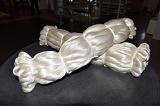Iyoito
| Registration Number | 10 |
|---|---|
| Name of the GI | Iyoito, Iyo Raw Silk |
| Class | Others |
| Date of Protection | 2016/02/02 |
| Producing Area |
Ehime Prefecture
Seiyo City |
| Applicant - Name and Address | Seiyo City Nomura Silk Museum 8-177-1 Nomura-cho-Nomura Seiyo City, Ehime Prefecture |
Iyo Raw Silk, compared to ordinary raw silk, has a graceful gloss like white camellia, a soft and fluffy texture, and is voluminous. When made into fabric, it has softness and warmth; when used for kimono, it does not easily loosen; and when used for obi, it tightens just right, and in that sense it is extraordinary. Its quality is highly appreciated, and from ancient times, it has been supplied to Ise Shrine and the Imperial family.
In typical domestic production areas, a method is adopted of reeling from a silkworm cocoon which has been heated and dried. When the cocoon is heated and dried, the pupa (silkworm) inside does not break out of the cocoon as a moth, and molds do not grow in the cocoon as it is in a dry state. For reeling throughout the year, this method is suitable for long-term preservation of cocoons harvested in large quantities at one time.
On the other hand, the main feature in the production of Iyo Raw Silk is that it uses raw cocoons. Since the cocoon is a protein made by insects, even a slight amount of heat will make it hard. Based on the idea that to get the best from silk, silk from a raw cocoon is superior, Iyo Raw Silk is made by an old-fashioned method using cocoons which are kept refrigerated in the raw state, as raw material. By doing so, the undulations in the yarn fiber made by silkworms squirting the silk in an S shape remains intact, and as compared with raw silk from other production areas, it is fluffy with a weight per volume of 2/3 or less.
The reeling work is done using traditional manual machines and water from the Shikoku cordillera. As compared to automatic machines used in other production areas, manual machines run at low speed while suppressing the tension of the thread which is troublesome and inefficient, but this method gives good results, and preserves the unique gloss and soft texture.
With the beneficial geographical and climatic conditions, the sericulture industry in this area began in the early Meiji Period (around the 1900s), and it had its heyday in early Showa (1930-1940s). But with declining demand for domestic kimono and the intrusion of inexpensive foreign-made silk, it gradually faded. Today, the traditional machinery manufacturing method, culture, and production of Iyo Raw Silk are retained only at the Nomura Silk Museum to supply consumer demand for high-class silk.


